TRIANGLE SUM THEOREM WORKSHEET
Subscribe to our ▶️ YouTube channel 🔴 for the latest videos, updates, and tips.
1. Prove that the sum of the measures of the interior angles of a triangle is 180°.
2. Can 30°, 60° and 90° be the angles of a triangle ?
3. Find the missing angles in the triangle shown below.
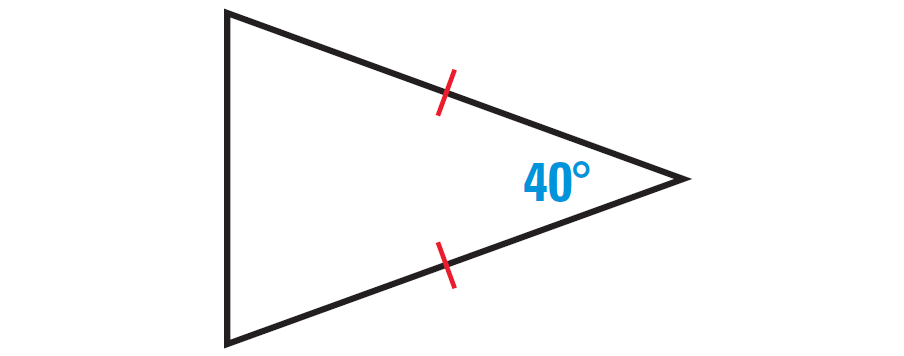
4. The measure of one acute angle of a right triangle is two times the measure of the other acute angle. Find the measure of each acute angle.
5. Find the missing angles in the triangle shown below.
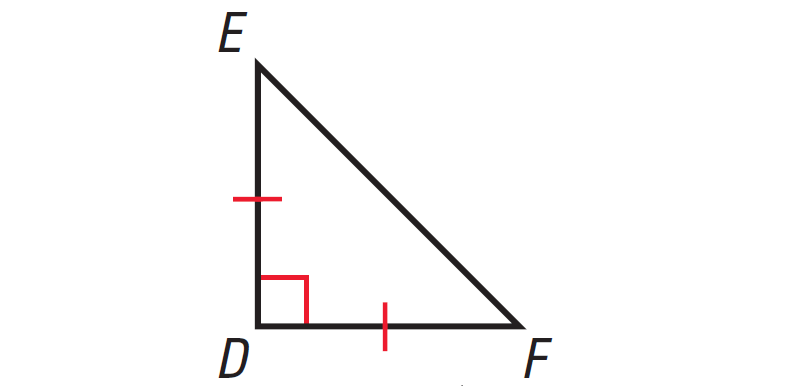
6. In a triangle, If the second angle is 5° greater than the first angle and the third angle is 5° greater than second angle, find the three angles of the triangle.
7)
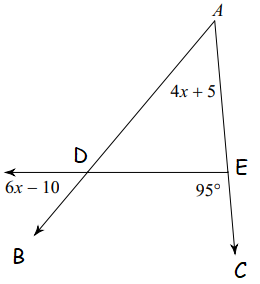
8) In a triangle ABC, ∠ A = 2X+7, ∠ B = 5X-9, and ∠ C = 6X. What is the value of x and what are the measures of angles A, B, and C?
9) Two angles of a triangle have equal measures, but the third angle's measure is 36° less than the sum of the other two. Find the measure of each angle of the triangle.
10) Find the measures of the angles of an isosceles triangle if the measure of the vertex angle is 40 degrees less than the sum of the measures of the base angles

1. Answer :
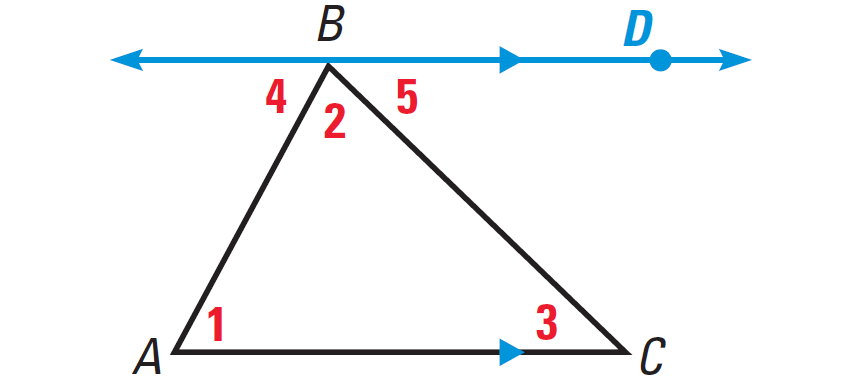
Given :
Triangle ABC.
To Prove :
m∠1 + m∠2 + m∠3 = 180°
Plan for Proof :
By the Parallel Postulate, we can draw an auxiliary line through point B and parallel to AC. Because ∠4, ∠2 and ∠5 form a straight angle, the sum of their measures is 180°.
We also know that ∠1 ≅ ∠4 and ∠3 ≅ ∠5 by the Alternate Interior Angles Theorem.
|
Statements Draw BD parallel to AC m∠4 + m∠2 + m∠5 = 180° |
Reasons Parallel Postulate Angle addition postulate and definition of straight angle. |
|
∠1 ≅ ∠4, ∠3 ≅ ∠5 |
Alternate Interior Angles Theorem |
|
m∠1 = m∠4, m∠3 = m∠5 |
Definition of congruent angles. |
|
m∠1 + m∠2 + m∠3 = 180° |
Substitution property of equality. |
2. Answer :
Let us add all the three given angles and check whether the sum is equal to 180°.
30° + 60° + 90° = 180°
The sum of the three angles is equal 180°. By Triangle Sum Theorem, the given three angles can be the angles of a triangle.
3. Answer :
In the triangle shown above, two sides are congruent. Angles opposite to congruent sides are always congruent.
So, if one missing angle is assumed to be x°, then the other missing angle also must be x°. Because the two angles are congruent.
The diagram shown below illustrates this.
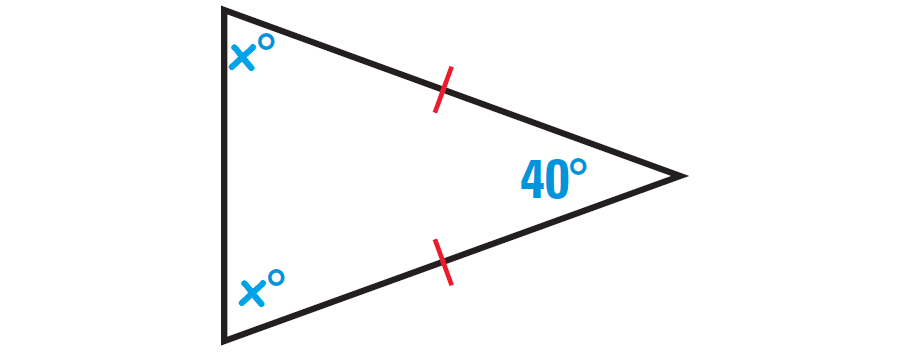
By Triangle Sum Theorem, the sum of the measures of the interior angles of a triangle is 180°.
So, we have
x° + x° + 40° = 180°
Simplify.
2x + 40 = 180
Subtract 40 from both sides.
2x = 140
Divide both sides by 2.
x = 70
So, the measure of each missing angle is 70°.
4. Answer :
Let A, B and C be the vertices of the triangle and right angle is at C.
Let ∠A = x°, then ∠B = 2x°. The diagram shown below illustrates this.

By Corollary to the Triangle Sum Theorem, the acute angles of a right triangle are complementary.
So, we have
x° + 2x° = 90°
Simplify.
3x° = 90°
Divide both sides by 3.
x = 30
So, m∠A = 30° and m∠B = 2(30°) = 60°
So, the two acute angles are 30° and 60°.
5. Answer :

In the triangle shown above, two sides are congruent. Angles opposite to congruent sides are always congruent.
So, if one missing angle is assumed to be x°, then the other missing angle also must be x°. Because the two angles are congruent.
The diagram shown below illustrates this.
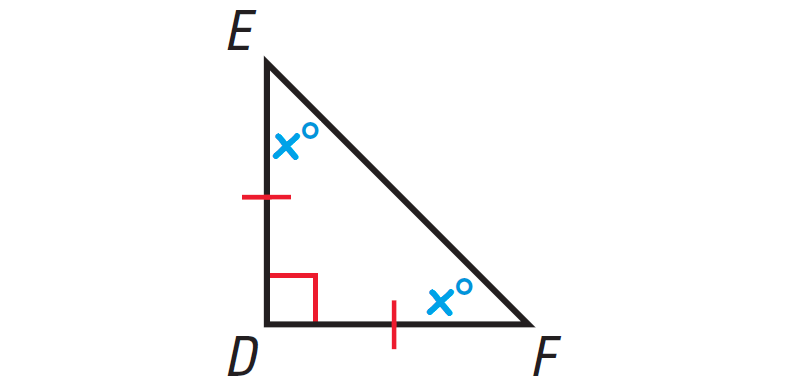
In the triangle shown above, one of the angles is right angle. So, it is right triangle.
By Corollary to the Triangle Sum Theorem, the acute angles of a right triangle are complementary.
So, we have
x° + x° = 90°
Simplify.
2x = 90
Divide both sides by 2.
x = 45
So, the measure of each missing angle is 45°.
6. Answer :
Let x° be the first angle.
The second angle = (x + 5)°
The third angle = x + 5 + 5 = (x + 10)°
We know that,
the sum of the three angles of a triangle = 180°
x + (x+5) + (x+10) = 180
3x + 15 = 180
3x = 165
x = 55
The first angle = 55°
The second angle = 55 + 5 = 60°
The third angle = 60 + 5 = 65°
So, the three angles of a triangle are 55°, 60° and 65°.
7. Answer :

<ADE = 6x - 10(Vertical angles)
<DEC + <DEA = 180
95 + <DEA = 180
<DEA = 180 - 95
<DEA = 85
<ADE + <DEA + <DAE = 180
6x - 10 + 85 + 4x + 5 = 180
10x + 90 - 10 = 180
10x + 80 = 180
10x = 180 - 80
10x = 100
x = 100/10
x = 10
8. Answer :
∠A = 2X + 7, ∠B = 5X - 9, and ∠C = 6X
Sum of interior angles = 180
2x + 7 + 5x - 9 + 6x = 180
13x - 2 = 180
13x = 180 + 2
13x = 182
x = 14
|
∠A = 2X + 7 = 2(14) + 7 = 28 + 7 = 35 |
∠B = 5X - 9 = 5(14) - 9 = 70 - 9 = 61 |
∠C = 6X = 6(14) = 84 |
9. Answer :
Let x be the equal angles.
Third angle = 2x - 36
x + x + 2x - 36 = 180
4x - 36 = 180
4x = 180 + 36
4x = 216
x = 216/4
x = 54
2x - 36 = 2(54) - 36 ==> 72
So, the three angle measures are 54, 54 and 72.
10. Answer :
Let x be the measures of isosceles triangle.
vertex angle = 2x - 40
x + x + 2x - 40 = 180
4x - 40 = 180
4x = 180 + 40
4x = 220
x = 220/4
x = 55
2x - 40 = 2(55) - 40
= 110 - 40
= 70
So, the three angle measures are 55, 55 and 70
Subscribe to our ▶️ YouTube channel 🔴 for the latest videos, updates, and tips.
Kindly mail your feedback to v4formath@gmail.com
We always appreciate your feedback.
About Us | Contact Us | Privacy Policy
©All rights reserved. onlinemath4all.com
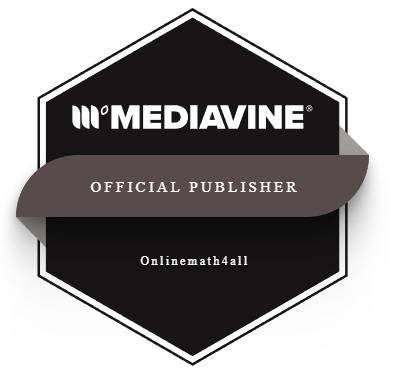
Recent Articles
-
10 Hard SAT Math Questions (Part - 43)
Jan 04, 26 01:38 AM
10 Hard SAT Math Questions (Part - 43) -
90 Degree Clockwise Rotation
Jan 01, 26 06:58 AM
90 Degree Clockwise Rotation - Rule - Examples with step by step explanation -
US Common Core K-12 Curriculum Algebra Solving Systems of Equations
Jan 01, 26 04:51 AM
US Common Core K-12 Curriculum - Algebra : Solving Systems of Linear Equations
